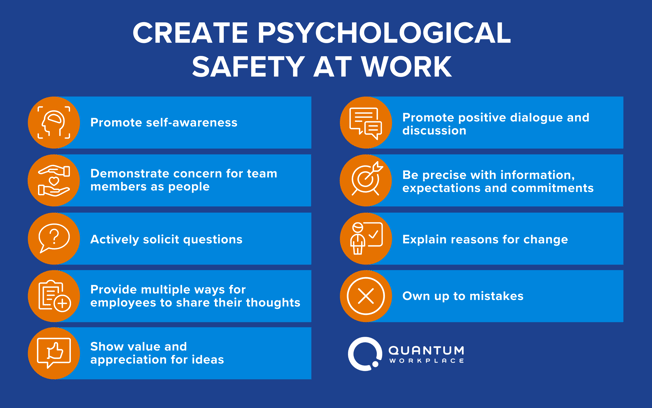
 As a leader, one of your top priorities is to help your team members succeed and feel engaged with their work. But if you don't create psychological safety at work, those ambitions will not be possible.
As a leader, one of your top priorities is to help your team members succeed and feel engaged with their work. But if you don't create psychological safety at work, those ambitions will not be possible.
In fact, data from Gallup reveals that just three in 10 U.S. workers strongly agree that their opinions seem to count at work. Further, one study revealed that by moving that ratio to six in 10 employees, organizations would realize a 27% reduction in turnover.
In this article, we'll talk about what psychological safety is, why it matters, and strategies for creating it at work.
Dr. Amy Edmondson, the Harvard Business School professor who coined the term psychological safety, defines it as, "a belief that one will not be punished or humiliated for speaking up with ideas, questions, concerns or mistakes."
Edmondson pointed to psychological safety as a critical factor for high-performing teams. More recently, Google's research on characteristics of high-performing teams identified psychological safety as their top indicator of the performance of a team.
Teams with strong psychological safety are less afraid of the negative consequences that may result from:
Teams that feel empowered to share their perspectives with each other, especially when their opinions differ from the rest of the group, are able to more fully leverage the knowledge and talent that each member brings to the team. These teams are more likely to take initiative and consider the full picture of each situation. This in turn enables the team to innovate and find effective solutions.
Psychological safety is also critical to a team's ability to give and receive candid, respectful feedback. If your organization is looking to build a stronger feedback culture, take a look at employee perceptions of psychological safety as a starting point.
When it comes to performance, creating a trusting environment is essential. The Harvard Business Review has shared multiple studies that describe psychological safety as an important factor in high-performing (and hybrid) teams, and the teams who are most effective at problem solving have been shown to share two common traits: cognitive diversity and psychological safety.
Not only does psychological safety improve your team’s performance, it also enhances employee engagement. When team members feel that their insights are appreciated they:
Psychological safety is a key component of diversity, equity, and inclusion efforts. Diverse opinions, experiences, and knowledge can be better leveraged if team members feel comfortable speaking up and are accustomed to considering alternate viewpoints. Highly inclusive teams are empowered to share their unique perspectives with each other and are better positioned to reap the benefits of having a diverse team.
One way to measure psychological safety in your organization is through employee surveys. However, traditional psychological safety assessments tend to focus solely on perceptions at the team level. Consider asking questions that measure employees' perceptions of psychological safety both at work and within their team.
Leverage a pulse survey template to ask the right questions about whether team members feel that they can share their opinions, take risks, and make mistakes.
When reviewing your results, focus your data analysis at the team-level, rather than within the organization overall. While it's valuable to have an understanding of the level psychological safety throughout your organization, any action that you take to improve psychological safety will be most effective within teams.
Now that you know what it is, why it matters, and how to measure it—how do you transform your team environment and create psychological safety at work? Try using these nine strategies to create psychological safety at work.

To create psychological safety in the workplace, start by building self-awareness in your team. When you recognize how you prefer to think and behave, you can uncover biases that might be impacting your employees’ willingness to share their viewpoints.
Self-awareness also empowers you to understand your typical responses to changes or challenges. With this knowledge, you can adjust your emotional responses and learn to react in a way that invites open discussion.
There are multiple ways to begin building self-awareness, including using 360° reviews and assessments like the Emergenetics Profile to better understand yourself and your team.
You may or may not be naturally inclined to ask team members how they are doing. Still, by getting into the practice of checking in with your employees, you demonstrate your concern and interest in them as people. Taking this simple action can help team members feel more comfortable speaking up because they know you appreciate their whole selves – not just their work product.
As your team is arriving at a decision, pause your meeting to ask for questions, different viewpoints and considerations that have not yet been voiced. And, count to ten in your mind before moving on. Often, internal processors may need more time to formulate their thoughts before voicing them, so train yourself to pause and encourage input.
While some employees may be comfortable sharing their thoughts in a meeting, others may prefer to have more time to think through their responses. Encourage team members to share feedback via email or through online collaboration tools, like Slack or Microsoft Teams, in addition to in-person discussions.
If you truly want your employees to openly share their thoughts, you must establish an environment where they feel all ideas are welcome. As you brainstorm, suspend judgement. Remember, you do not need to act on every idea; however, thanking people for their contributions and showing appreciation for their insights will go a long way in establishing psychological safety.
Encourage team members to use positive language to inspire honest conversations. Cognitive studies have shown that affirmative language can actually motivate you to succeed. Simple word changes like using “have not yet” in place of “can’t” or “opportunity” instead of “challenge” can help your team members employ a positive mindset that empowers them to speak up without fear.
To build psychological safety, your team members need to trust you and your word, so be mindful about the information you share as well as the expectations and commitments you set. Be accurate. Be realistic. And, be thoughtful. Setting clear expectations and adhering to your commitments will help employees trust you and be more open with you.
In the course of business, timelines will shift and your plans will need to adjust. Some of your team members will have an easy time transitioning while others may be thrown. When expectations change or new information is revealed, be clear about what changed and why and give your team members time to process the change.
Failure can be frightening, and as a leader, you can take the sting out of it for your employees by owning up to the mistakes you’ve made and celebrating failures as learnings. Regularly ask employees what they’ve done that didn’t work out as expected and what they learned from those experiences. Doing so will help team members recognize that they won’t be punished for mistakes and help them feel more comfortable taking risks and speaking up.
As a leader, the tone you set for your team has the power to make or break your employees’ success and engagement. When you employ these nine strategies to build psychological safety, you will empower your employees to share their ideas, learnings and concerns, which will spark your team’s performance.
Relationships are critical to the success, engagement, and psychological safety of individuals and teams at work. Download our ebook, The Relationship-Driven Workplace, to learn how you can build (and measure) better relationships in your workplace.
Published June 3, 2021 | Written By Shana Bosler